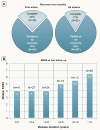Contrasting disease patterns in seropositive and seronegative neuromyelitis optica: A multicentre study of 175 patients
- PMID: 22260418
- PMCID: PMC3283476
- DOI: 10.1186/1742-2094-9-14
Contrasting disease patterns in seropositive and seronegative neuromyelitis optica: A multicentre study of 175 patients
Abstract
Background: The diagnostic and pathophysiological relevance of antibodies to aquaporin-4 (AQP4-Ab) in patients with neuromyelitis optica spectrum disorders (NMOSD) has been intensively studied. However, little is known so far about the clinical impact of AQP4-Ab seropositivity.
Objective: To analyse systematically the clinical and paraclinical features associated with NMO spectrum disorders in Caucasians in a stratified fashion according to the patients' AQP4-Ab serostatus.
Methods: Retrospective study of 175 Caucasian patients (AQP4-Ab positive in 78.3%).
Results: Seropositive patients were found to be predominantly female (p < 0.0003), to more often have signs of co-existing autoimmunity (p < 0.00001), and to experience more severe clinical attacks. A visual acuity of ≤ 0.1 during acute optic neuritis (ON) attacks was more frequent among seropositives (p < 0.002). Similarly, motor symptoms were more common in seropositive patients, the median Medical Research Council scale (MRC) grade worse, and MRC grades ≤ 2 more frequent, in particular if patients met the 2006 revised criteria (p < 0.005, p < 0.006 and p < 0.01, respectively), the total spinal cord lesion load was higher (p < 0.006), and lesions ≥ 6 vertebral segments as well as entire spinal cord involvement more frequent (p < 0.003 and p < 0.043). By contrast, bilateral ON at onset was more common in seronegatives (p < 0.007), as was simultaneous ON and myelitis (p < 0.001); accordingly, the time to diagnosis of NMO was shorter in the seronegative group (p < 0.029). The course of disease was more often monophasic in seronegatives (p < 0.008). Seropositives and seronegatives did not differ significantly with regard to age at onset, time to relapse, annualized relapse rates, outcome from relapse (complete, partial, no recovery), annualized EDSS increase, mortality rate, supratentorial brain lesions, brainstem lesions, history of carcinoma, frequency of preceding infections, oligoclonal bands, or CSF pleocytosis. Both the time to relapse and the time to diagnosis was longer if the disease started with ON (p < 0.002 and p < 0.013). Motor symptoms or tetraparesis at first myelitis and > 1 myelitis attacks in the first year were identified as possible predictors of a worse outcome.
Conclusion: This study provides an overview of the clinical and paraclinical features of NMOSD in Caucasians and demonstrates a number of distinct disease characteristics in seropositive and seronegative patients.
Figures



References
-
- Wingerchuk DM, Hogancamp WF, O'Brien PC, Weinshenker BG. The clinical course of neuromyelitis optica (Devic's syndrome) Neurology. 1999;53:1107–1114. - PubMed
-
- Jarius S, Franciotta D, Bergamaschi R, Wright H, Littleton E, Palace J, Hohlfeld R, Vincent A. NMO-IgG in the diagnosis of neuromyelitis optica. Neurology. 2007;68:1076–1077. doi: 10.1212/01.wnl.0000256822.01222.bd. - DOI - PubMed
-
- Waters P, Jarius S, Littleton E, Leite MI, Jacob S, Gray B, Geraldes R, Vale T, Jacob A, Palace J, Maxwell S, Beeson D, Vincent A. Aquaporin-4 antibodies in neuromyelitis optica and longitudinally extensive transverse myelitis. Arch Neurol. 2008;65:913–919. doi: 10.1001/archneur.65.7.913. - DOI - PubMed
Publication types
MeSH terms
Substances
LinkOut - more resources
Full Text Sources
Other Literature Sources
Miscellaneous

